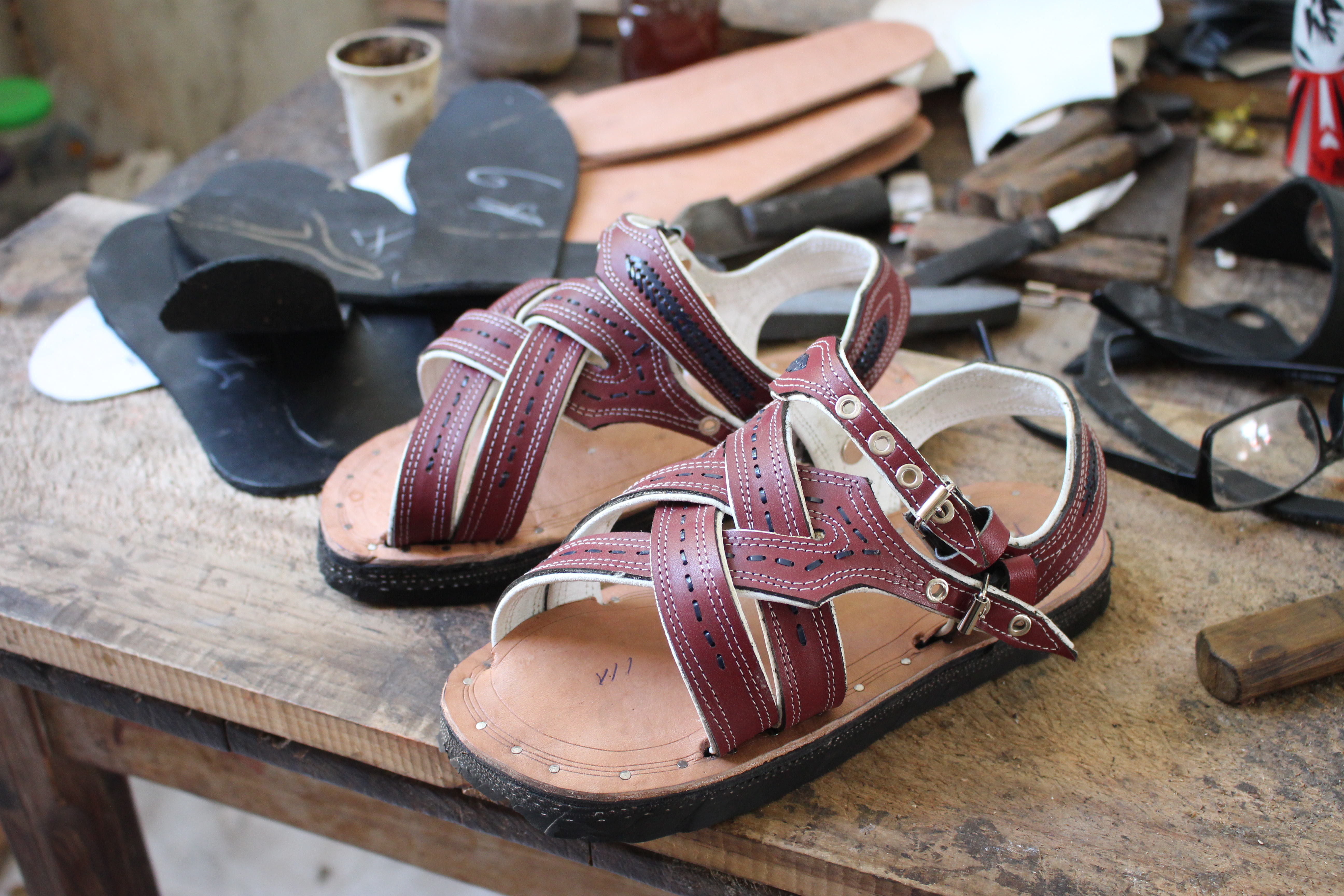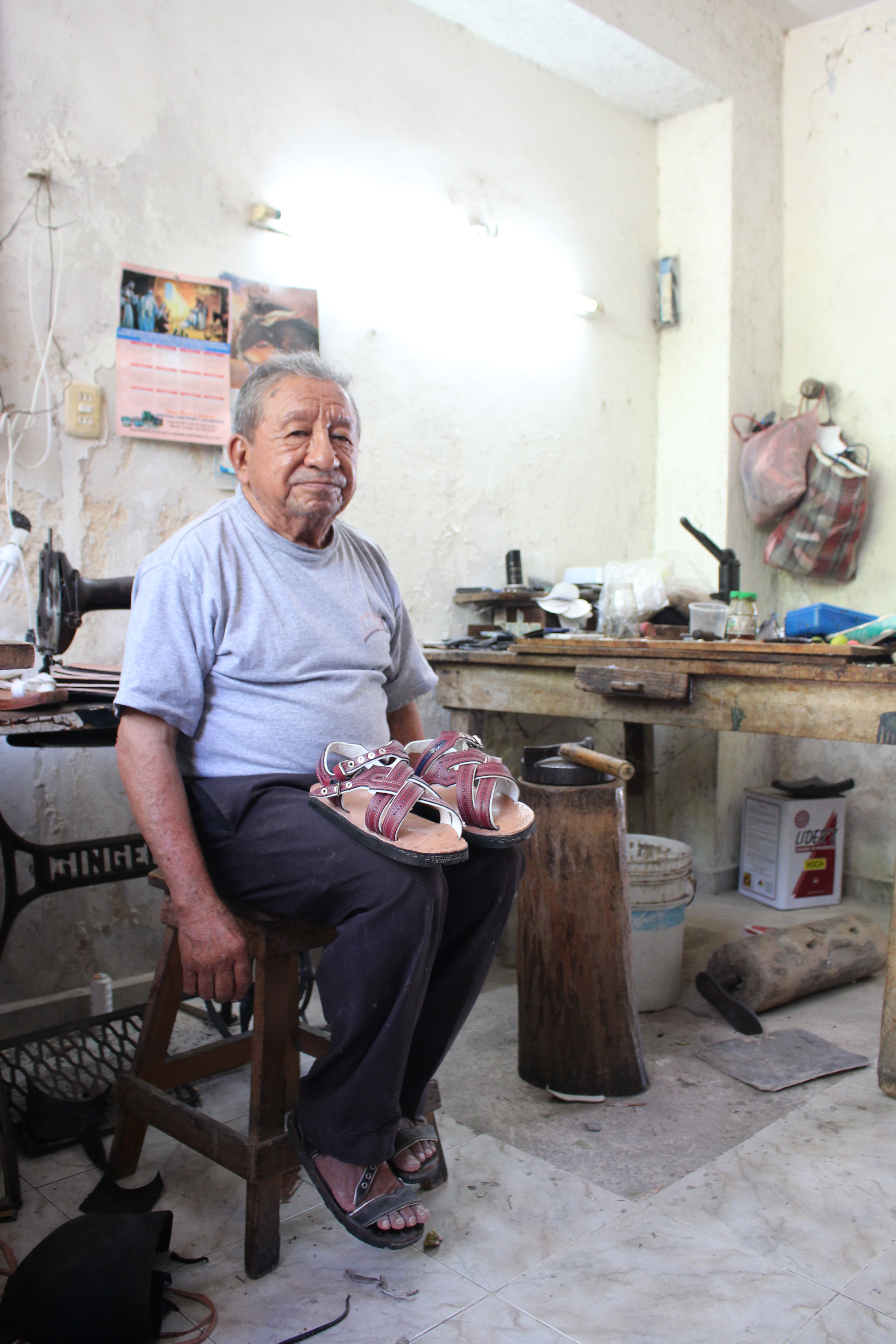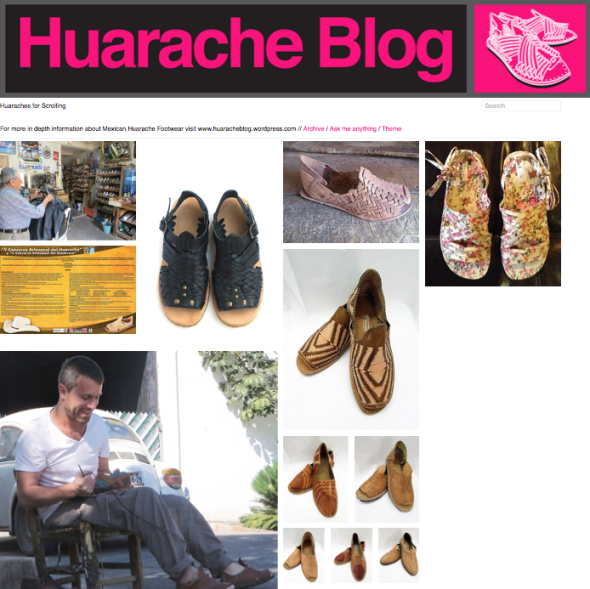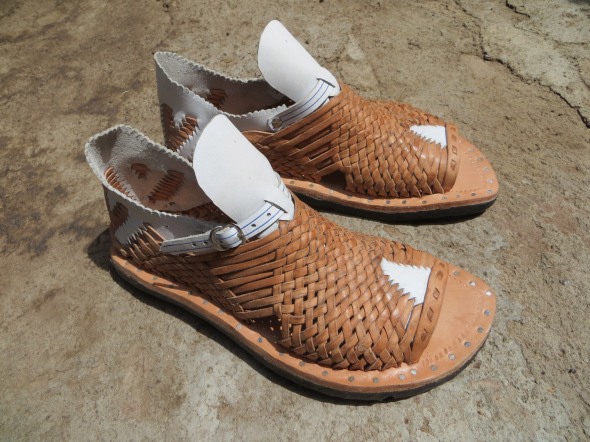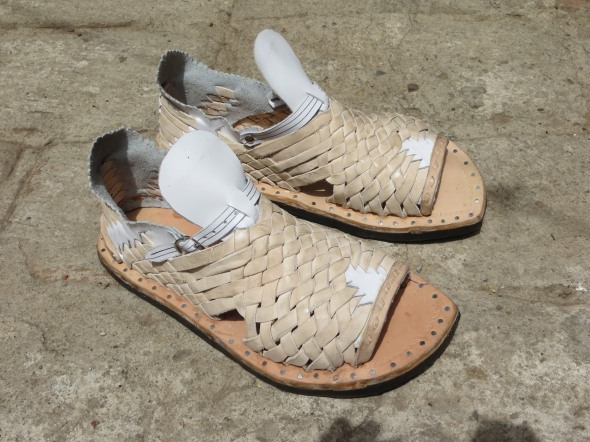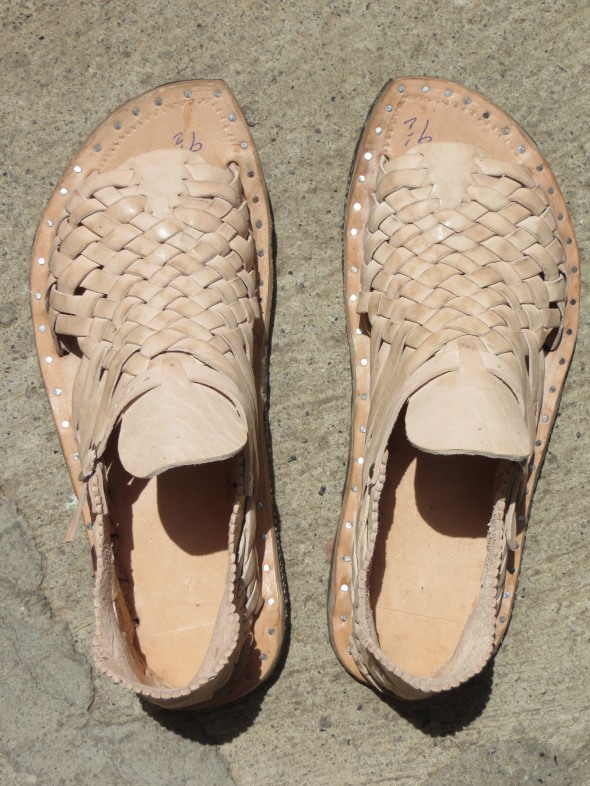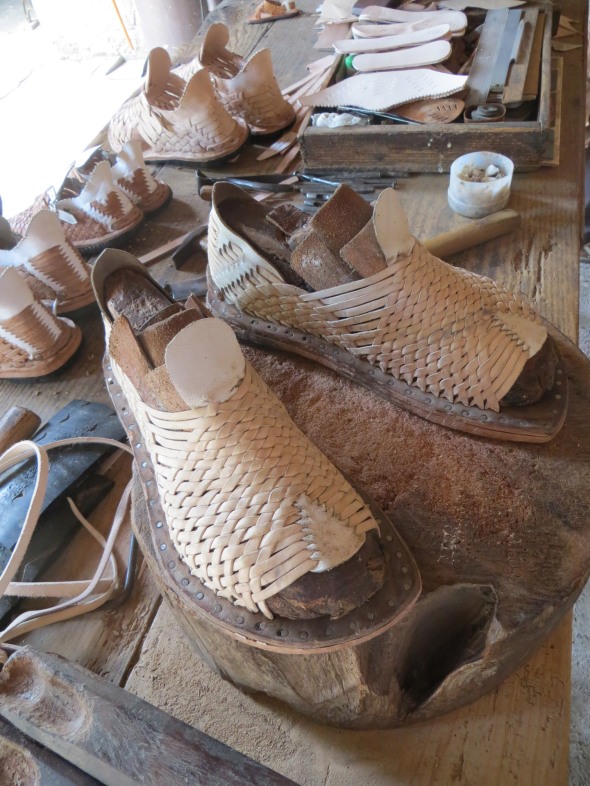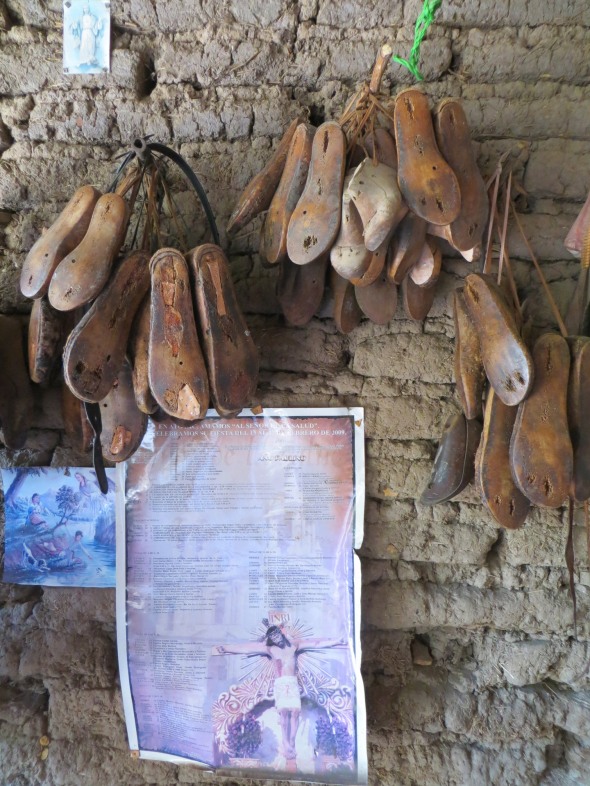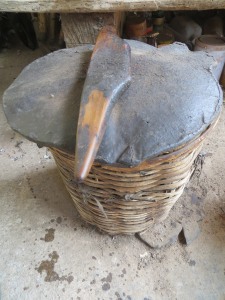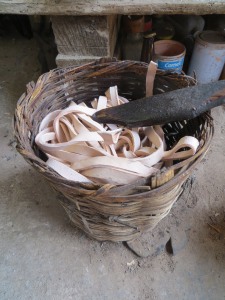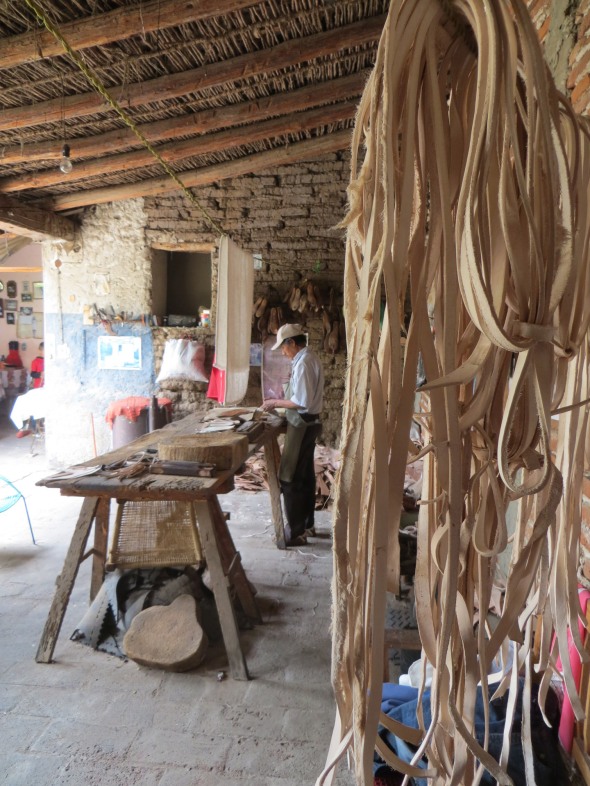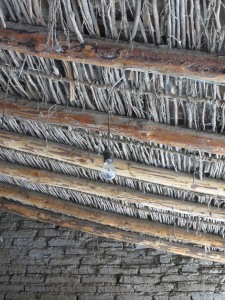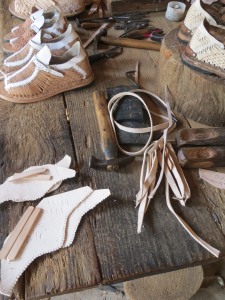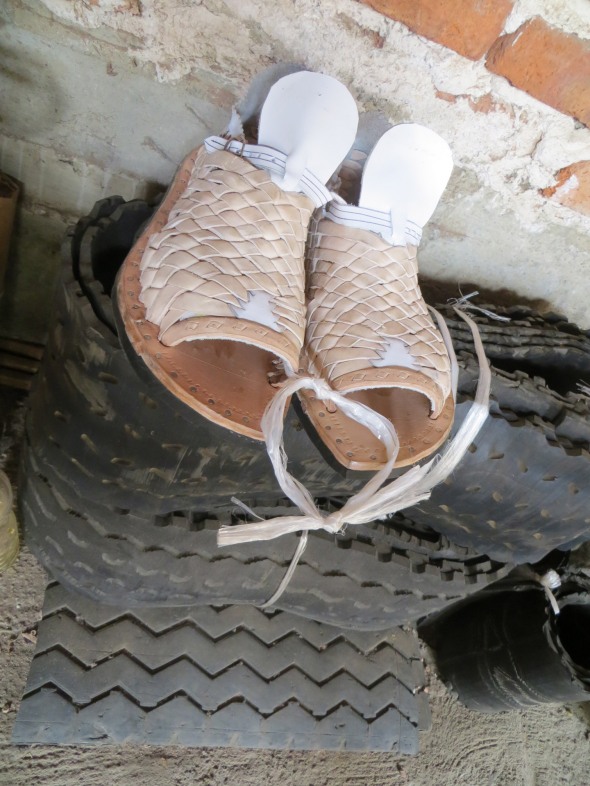Where to Buy Huaraches in Gran Canaria and Tenerife, Spain
Posted: May 8, 2023 Filed under: Uncategorized Leave a commentThe Canary Islands have a small Huarache tradition that goes back at least 50 years and about which very little is known about.
And if you happen to be on the Island of Gran Canaria, there are still a few places where you can find an original pair of Canarian Huaracho. Which unlike Mexican Huaraches of today, Canarian Huarachos are still made by weaving single, very long strip of leather.
There are 3 shops in the capital city of Las Palmas :-
Fran López – C. Senador Castillo Olivares, 33, 35003 Las Palmas de Gran Canaria
Artesania Guarapo – C. Pavía, 25, 35010 Las Palmas de Gran Canaria
FEDAC- C. Domingo J Navarro, 7, 35002 Las Palmas de Gran Canaria
On Sundays at the La Vegueta Mercadillo behind the Cathedral you can usually find Martin weaving Huarachos.
Then in the nearby towns of Arucas :-
Zapatería Jiménez – C. Cronista Juan Zamora Sánchez, 13, 35400 Arucas
And in Telde :-
Zapateria Cuchilleria “La Llave” – CC Hiperdino Melenara Local 38 y C/Maestro Nacional-Calero Bajo, 35215, Telde
In Tenerife you can buy Huarachos from Ramón El Gomero who has a stand at the municipal market in Santa Cruz, of Friday, Saturday and Sunday.
The story of Canarian Huaracho also called Guaracho, Huaracha, or Guaracha has a few interesting twists.
While the style may originate from Mexico, it did not exist until recently in Mexico (maybe forgotten), but has been one of the main styles made in the Canaries since the 1970’s.
Originally made in hippy/traveller communities selling at craft markets, or on the street in the Canary islands, the informal nature of the craft in the Canaries could also be the reason for so many names.
Interestingly the style found its way back to Mexico via Italy, where a man known as Jeff who had lived in the Canaries taught others in an ecovillage community deep in the mountains in Tuscany.
But the move back across the Atlantic ocean happened about 10 years ago, 2 pairs were bought for 750 Euros each in a luxury menswear shop in Florence by an American leather goods businessman on holiday, who developed the shoe last and started making them in Mexico for his brand in the USA.
Today this style is again produced in Mexico for several US brands, but only for export and is probably their most popular men’s style, but it also continues to be made by a few artisans in the Canaries for local sale and in Italy.
I would say that the style of the Canarian Huaraches, is also a bit more open and I’m not sure why, but maybe also a bit more European, as it should probably be. See for yourself on the Instagram page of Huarache Blog.
======================================================================
Dónde Comprar Huaraches en Gran Canaria y Tenerife, España
Las Islas Canarias tienen una pequeña tradición Huarache que se remonta al menos a 50 años y de la que se sabe muy poco.
Y si por casualidad te encuentras en la Isla de Gran Canaria y de Tenerife, todavía hay algunos lugares donde puedes encontrar un original par de Huarachos Canarios. Que, a diferencia de los Huaraches Mexicanos de hoy, los Huarachos Canarios todavía se fabrican tejiendo una sola tira de cuero muy larga.
Hay 3 tiendas en la ciudad capital de Las Palmas :-
Fran López – C. Senador Castillo Olivares, 33, 35003 Las Palmas de Gran Canaria
Artesania Guarapo – C. Pavía, 25, 35010 Las Palmas de Gran Canaria
FEDAC- C. Domingo J Navarro, 7, 35002 Las Palmas de Gran Canaria
Los domingos en el Mercadillo de La Vegueta detrás de la Catedral se suele encontrar a Martín tejiendo Huarachos.
Luego en los pueblos cercanos de Arucas :-
Zapatería Jiménez – C. Cronista Juan Zamora Sánchez, 13, 35400 Arucas
Y en Telde :-
Zapateria Cuchilleria “La Llave” – CC Hiperdino Melenara Local 38 y C/Maestro Nacional-Calero Bajo, 35215, Telde
En Tenerife puedes comprar Huarachos de Ramón El Gomero que tiene un puesto en el mercado municipal de Santa Cruz, los días viernes, sábado y domingo.
La historia del Huaracho canario también llamado Guaracho, Huaracha o Guaracha tiene algunos giros interesantes.
Si bien el estilo puede tener su origen en México, no existió hasta hace poco en México (tal vez olvidado), pero ha sido uno de los principales estilos elaborados en Canarias desde la década de 1970.
Originalmente elaborado en comunidades hippies/viajeros que vendían en mercados de artesanía, o en la calle en Canarias, el carácter informal de la artesanía en Canarias también podría ser la razón de tantos nombres.
Curiosamente, el estilo encontró su camino de regreso a México a través de Italia, donde un hombre conocido como Jeff, que había vivido en Canarias, enseñó a otros en una comunidad de ecoaldeas en lo profundo de las montañas de la Toscana.
Pero el viaje de regreso al otro lado del océano Atlántico ocurrió hace unos 10 años, se compraron 2 pares por 750 euros cada uno en una lujosa tienda de ropa masculina en Florencia por un empresario estadounidense de artículos de cuero que estaba de vacaciones, quien desarrolló la horma y comenzó a fabricarlos en México para su marca en USA.
Hoy en día, este estilo se vuelve a producir en México para varias marcas estadounidenses, pero solo para exportación y es probablemente el estilo masculino más popular, pero también continúa siendo elaborado por algunos artesanos en Canarias para la venta local y en Italia.
Yo diría que el estilo de los Huaraches canarios, también es un poco más abierto y no sé por qué, pero quizás también un poco más europeo, como probablemente debería ser. Compruébelo usted mismo en la página de Instagram de Huarache Blog.
Huaraches auf Gran Canaria und Teneriffa, Spanien, kaufen, acheter des Huaraches à Gran Canaria et Tenerife, comprare Huaraches a Gran Canaria e Tenerife, Купить Huaraches на Гран-Канарии и Тенерифе
The Fine Alpargatas of Don Pio
Posted: March 30, 2020 Filed under: Huarache Artisan, Huarache Culture, Huarache Sandals, Uncategorized | Tags: ハンドメイド・シューズ, メキシコのサンダル, ワラチ, चमड़े के सैंडल, बुना सैंडल, मेक्सिको सैंडल, हस्तनिर्मित सैंडल, 皮凉鞋, 编织凉鞋, Мексиканские сандалии, 革のサンダル, 멕시코 샌들, Gewebten Sandalen, Geweven Sandalen, Guaraches, Handgefertigte Sandalen, Handgjorda Sandaler, Handmade Sandals, Håndlagde Sandaler, Huaraches, 짠 샌들, Lädersandaler, Leather Sandals, Ledersandalen, Leren Sandalen, Meksikanske Sandaler, Mexicaanse Sandalen, Mexican Sandals, Mexikanischen Sandalen, Mexikanska Sandaler, тканые сандалии, Sandales à la main, Sandales en Cuir, Sandales Mexicains, Sandales Tissées, Sandali fatti a mano, Sandali in Pelle, Sandali Intrecciati, Sandali Messicani, Sandalias de Cuero, Sandalias Hechas a Mano, Sandalias Tejidas, Skinn Sandaler, Vävda Sandaler, Vevde Sandaler, Woven Sandals, 墨西哥凉鞋, 手工凉鞋, 手作りのサンダル, 不織布サンダル, المكسيكي الصنادل, المنسوجة الصنادل, الجلود والصنادل, الصنادل المصنوعة يدويا Leave a commentA few weeks ago, while on holiday in Mexico I visited Senor Porfirio Montero Ortiz in Umán, a small town just south west of Merida, Yucatán.
“Don Pio” as he is affectionately known by everyone locally, has been making Alpargatas for almost 60 years since he was just 12 years old.
This huge mural in the photo below was painted by a local artist called Arnold Daniel Cruz Cetina, also Datoer, or Datoergs on Instagram. And is part of a series of portraits called “Pintado Recuerdos”, or Painted Memories.
Like Huaraches, Alpargatas are traditional Mexican footwear from the Yucatán peninsula. The earliest style is probably the “Aplargatas de Orejas” meaning “Eared” Alpargatas (please use the search bar on the top right to find more posts). They are simply made from a leather sole and Henequen/Sisal chord, and are similar to the “Pata de Gallo” Huaraches from Central and Western Mexico.
Don Pio is a master craftsman and makes some of the best Alpargatas in the Yucatán peninsula, some of which have won prizes in regional crafts competitions. The quality of his work and detail of his designs means that at the most he can make not more than 2 pairs per day.
Probably the most iconic regional style of Alpargatas are the “Chillonas”, a man’s style which are often used for dancing the local Jarana Yucateca dance.
“Chillonas” literally means “Squeakers” and are called this way because of the squeaky sound created by the multi layered leather soles while dancing.
Then there is the interesting “De Cordel” Alpargata which is an embellished version of the “De Oreja” Alpargatas which are commonly worn in the countryside.
And the “Cruzado” Alpargata is also an embellished version of the traditional style sandals.
A true artisan, Don Pio also wears his own designs which is quite unusual for Huaracheros.
The workshop of Don Pio is at Calle 21 N.113, just located behind the Town Hall in Umán, Yucatán.
Tel. 999.448.5859 and 999.645.9839
And on Facebook https://www.facebook.com/Talabartería-Umán-181516822012752/
More photos soon on Huarache Blog on Instagram
Tejiendo Nuestros Pasos by Daniel Ysi Zarco
Posted: February 2, 2020 Filed under: Huarache Artisan, Huarache Culture, Huarache History, Making Huaraches, Uncategorized Leave a commentTejiendo Nuestros Pasos is a stunning and truly authentic short documentary that softly reveals the often overlooked humanity that lies behind Huaraches.
It follows 3 Huarachero Artisans through their Huarache making process, as they talk about their life in Tacambaro a small town in the south of Michoacan state.

Daniel Ysi Zarco and his team created and filmed this documentary in reaction to the closing of so many Huarache workshops in Tacambaro during his life, with the loss of local identity and economic self sufficiency caused by the growth of modern long range distribution and mass production.
“Profit and tradition in rural manufacture: Sandal production in Sahuayo, Michoacan, Mexico” – PhD Thesis by Victoria Forbes Adam
Posted: April 10, 2019 Filed under: Uncategorized | Tags: Crafts, Handmade Sandals, Huarache, Huarache Sandals, Huaraches, Mexican Sandals, Mexico, Sandals, Traditional Footwear 6 CommentsA few weeks ago Ana Alicia a reader of Huarache Blog kindly pointed me to a 25 year old PhD Thesis about Huaraches Production in Sahuayo, but which I wasn’t able to download.
But then following this post a few days ago I received a message from Alex who was able to very kindly download the Thesis for me.
I have just start reading it and it is very interesting, but also so very well written that I feel both kindred and a bit jealous of Victoria Forbes Adam’s perspective and talent. It appears to be very thorough research about the History of Huarache making in Sahuayo, from process to politics. Why the footwear making process in Sahuayo never fully industrialized like other parts of the world and why cooperatives never succeeded. So far I have read many points that based on my personal experience are still very relevant today, and I think that local government and Huarache workers in Sahuayo would also do well to learn about to develop this unique business further.
However to download the Thesis is not easy because you must first access the ProQuest thesis library/database which requires an affiliation with a University.
But as soon as I have read the Thesis, I will publish some excerpts which I think are the most interesting and relevant. In the meantime if you would like to find the Thesis to download yourself, the link below should take you straight there.
Adam, Victoria
ProQuest Dissertations Publishing:1994
ISBN:9781339558356
Thank you to everyone for your kind help.
Huarache Blog Now on Instagram!
Posted: April 6, 2019 Filed under: Uncategorized Leave a commentHuarache Blog is now also on Instagram with #onehuaracheaday sharing more interesting Huarache photos and Huarache insights everyday.
Please join me @ https://instagram.com/huaracheblog
Anukia the Pioneers of Coloured Huaraches
Posted: December 16, 2018 Filed under: Fashion Huaraches, Huarache Artisan, Huarache Culture, Huarache History, Huarache Sandals, Uncategorized Leave a commentNowadays brightly colored Huaraches are quite normal, but in 2010 when I first arrived in Mexico all Huaraches were either tan, or chocolate brown color..Sure there was also the Green, White and Red style worn by Wixarika, but unbelievably Huarache design didn’t include bright colours.
If 8 years ago you asked any artisan to make colored Huaraches and they would reply skeptically that “colored Huaraches looked strange and were not commercial”. I thought maybe because they were still mostly focusing on men’s styles.
And it was almost impossible to find affordable colored vegetable tanned leather in Mexico, because there was little to no demand for it.
Then around 2013, I noticed some bright purple and turquoise hand painted leather women’s Huarache styles. Despite admiring the improvised tenacity of Anukia, my first impression was that hand painting the natural colored tan leather looked crude and made the Huaraches look coated and unrefined.
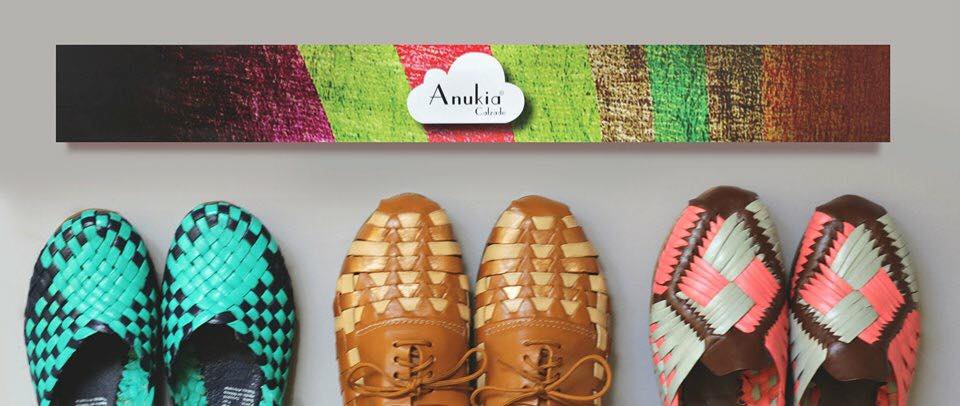
But the result was a surprising massive colorful explosion of leather weaves, mostly in the Huarache making town of Sahuayo, Michoacán.
And the beggining of a National and International Huarache tsunami, boom of colored women’s Huaraches which was a lifeline to the craft of Huarache making.
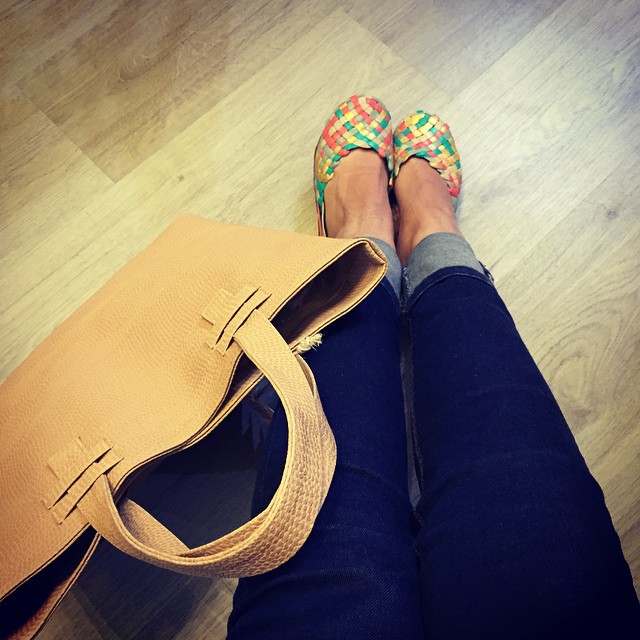
From some of the biggest international footwear fashion brands, to small social entrepreneur start-ups and the smallest family workshops, by 2015 the coloured Huarache had become a global footwear sensation.
Such a big demand also led to coloured veg. tan leather production and therefore even the few remaining Mexican veg. tanneries also benefitted. And today Huarache veg. tan leather has become widely available in many colours and has a rich smooth finish.
The Huarache craft is flourishing again and it all began thanks to Anukia who introduced a few hand painted coloured Huaraches, made in a small family workshop.

Anukia a creative couple from Guadalajara who started an International coloured Huaraches trend.
Anukia, the original coloured fashion Huarache.
To give credit, where credit is due, I recently contacted them to congratulate them. Please click to the next page, after the jump to read what they told me about their journey.
Please Share Huarache Blog and The Huarache Directory
Posted: December 16, 2018 Filed under: Huarache Culture, Huarache History, Huarache Sandals, Uncategorized 4 CommentsCompare the content of Huarache Blog and the Huarache Directory to other sources on Huaraches either online (pinterest, instagram, facebook), or in books and I think you will agree there exists nothing similar. Without travelling to Mexico, who, or where else can you learn about the craft of Mexican Huaraches, or contact Huarache Artisans directly?
Please share the link of this blog and the Huarache Directory if you think they are interesting.
Why?
Because despite tagging with multiple words including Huarache, Huaraches, or Guaraches, and the word Huarache being written countless times, unfortunately this Blog’s content is disappearing from Google search and being replaced and drowned out by commercial websites and photos of generic sport shoes and mass produced sandals.
And unfortunately the same is happening with http://www.thehuarachedirectory.wordpress.com the only resource dedicated to putting people directly in contact with Huarache artisans. I’m at a loss for words as to why this not for profit important service is being burried by less valuable content?
Without spending money on SEO agencies, I’m not sure how else can I promote the craft of Huaraches? Especially now that I no longer live in Mexico, it’s impossible for me to regularly update this blog.
Maybe the Google algorithm does not consider old blog posts relevant as newer publications. Or most Google users are looking specifically to buy Huarache branded sport shoes, so its hard to fault an algorithm that is doing an excellent job of identifying the most relevant websites.
But I’m saddened that over time fewer people will be able access, or come across this site via search engines and instead be shown links to retail providing only commercial mainstream footwear. For old Huarache Blog readers none of this will matter, but what about all the new readers? What Huarache content will be accessible to them online in the future?
Really, I wouldn’t mind if my Huarache infirmation was replaced by equally relevant, or better content. If someone in Mexico would post about the craft of Huaraches and promote Artisans I would gladly support and promote their blog. But so far no one seems to be stepping up.
It seems that Google search is becoming an online supermarket. I’ve noticed that Bing search results seem to be more inclusive, balanced and content selective.
Imagine if Wikipedia entries were replaced by commercial products and brands sharing the same name. If it became difficult to access informative content.
Unfortunately Wikipedia won’t even mention, or publish the link to Huarache Blog because their rules state that blogs are unreliable sources of information.
Is this the future we want for the internet?
The internet should be for learning and sharing, as much as it should be for buying.
If you happen to reach this blog, or the Huarache Directory and find them interesting, please mention it to your friends, or share their links, even to http://www.huaracheblog.tumblr.com which has an amazing and largest number of interesting Huarache photos to share, especially compared to any search engine.
Besides my Tumblr updates I don’t post much since leaving Mexico, but I think there doesn’t exist anywhere in the world such a big resource regarding the unique craft of Huaraches and traditional Mexican Woven Footwear.
When it comes to the craft of Huaraches, Huarache Blog contains more information than Facebook, Pinterest and even Instagram. It’s a shame to see it become relegated because of a simple technicality.
Thank you.
Markus
Fine Huaraches – MAP Exhibition Video
Posted: May 12, 2018 Filed under: Uncategorized 9 CommentsAfter just over 2 months my first Huarache exhibition at the MAP museum in Mexico City closed this week.
The Museo de Artes Populares is a very beautiful world class museum dedicated to Mexican Crafts. They are a true patron and I am so grateful for their interest and help.
Huarache Exhibition!
Posted: February 23, 2018 Filed under: Closed Toe Huaraches, Custom Huaraches, Huarache Culture, Huarache History, Huarache Sandals, Luxury Huaraches, Rare Huaraches Leave a commentAt long last, I’m very pleased share my Huaraches exhibition at the stunning MAP museum in Mexico City from Feb.28th to May 6th.
This unique exhibition will feature the finest and rarest bespoke traditional Mexican woven footwear.
The most complex leather weaves made by the most talented and few remaining Huarache Artisans.
This exhibition is a dream come true and I would like to thank @map_mexico museum very much.

Don’t Forget/ No Se Olvide Huarache Blog on/en Tumblr.
Posted: September 11, 2014 Filed under: Huarache Culture, Huarache Links, Huarache Sandals | Tags: Guaraches, Huarache Sandals, Huaraches 1 CommentClick HERE for Hundreds more Huarache photos!
Hagan clic AQUI para muchísimas más fotos de Huaraches!
Don Vincente and Don Lucas – Huaracheros From Atoyac, Jalisco
Posted: April 17, 2013 Filed under: Huarache Artisan, Huarache Culture, Huaraches Jalisco, Making Huaraches | Tags: メキシコのサンダル, ワラチ, चमड़े के सैंडल, बुना सैंडल, मेक्सिको सैंडल, हस्तनिर्मित सैंडल, Crafts, 编织凉鞋, Мексиканские сандалии, 革のサンダル, 멕시코 샌들, Footwear Design, Gewebten Sandalen, Geweven Sandalen, Handcrafted, Handgefertigte Sandalen, Handgjorda Sandaler, Handmade Sandals, Håndlagde Sandaler, Huarache, Huarache Sandals, Huarachero, Huaraches, 짠 샌들, Lädersandaler, Leather, Ledersandalen, Meksikanske Sandaler, Mexicaanse Sandalen, Mexican Crafts, Mexican Sandals, Mexico, Mexikanischen Sandalen, Mexikanska Sandaler, тканые сандалии, Sandales à la main, Sandales en Cuir, Sandales Mexicains, Sandales Tissées, Sandali fatti a mano, Sandali in Pelle, Sandali Intrecciati, Sandali Messicani, Sandalias de Cuero, Sandalias Guaraches, Sandalias Hechas a Mano, Sandalias Tejidas, Skinn Sandaler, Sustainable, Sustainable Footwear, Tannery, Tanning, Traditional Footwear, Vävda Sandaler, Vegetable Leather, Vevde Sandaler, Woven Footwear, 墨西哥凉鞋, 手工凉鞋, 手作りのサンダル, 不織布サンダル, المكسيكي الصنادل, المنسوجة الصنادل 14 CommentsVincente Torres Perez and Jacinto Lucas De La Cruz are the last remaining Huaracheros in Atoyac, Jalisco.
The Huaraches in Atoyac have the distinctively pointed soles. Srs. Torres and Lucas make many styles and their most popular are the “Tejido” in the “Finito” (fine weave) version.
The “Tejido Sencillo” Huarache with the “Fuerza” strip of leather on the toe.
And the “Tejido Sencillo” Huarache.
They also refurbish old Huaraches, something I have never seen before. In this case the customer wanted to keep the original leather sole and an new upper was woven into it.
All their Huaraches are made using the same traditional techniques using wooden mesquite lasts.
Many Huaraches are also made to measure.
All the strips of leather are softened in oil and water and left to dry overnight before weaving.
The workshop “Taller” where Don Vincente and Don Lucas work is about as authentic as it gets.
A cool open space with adobe walls and a thatched roof, old wooden tools and vegetable tanned leathers abounding.
They still had a child’s version to the traditional field Huarache the “Alcapoyo”. This Huarache style is one of the oldest and simplest styles. The likely successor of the “Pata de Gallo” and the design bridging that to the complex woven ones we see today.
For orders Don Vincente and Don Lucas can be reached at the following NEW number: 372.410.2115
Hand Eye Article Including Huarache Blog
Posted: March 26, 2023 Filed under: Uncategorized Leave a commentAs time goes by, websites and posts come, and so the information on the internet eventually also disappears. Therefore I would like to publish the transcripts of some interesting and well written articles which I have been involved in about Huaraches before they also inevitably are taken down one day.
The original articles are also linked since they also include interesting photos from Huarache Blog.
Master and Maker of Mexican Huaraches
BY MARKUS KITTNER October 13, 2011
Señor Armando’s woven wonders
Señor Armando is a Mexican huarachero, or huarache maker who will retire soon. When I approached him on behalf of a Canadian company that was interested in collaborating with him to design sandals, he declined and flatly stated he wanted to “work less, not more.”
Huaraches are traditional Mexican sandals. Their origins are unknown, but there are clear design links between modern huaraches such as Mayan Caites sandals and Pre-Hispanic footwear seen on ancient codices. However, the introduction of cheaper factory manufactured goods has taken its toll on sales and income for craftspeople Like Señor Armando who leaves his trade with no one to continue his work or support his business.
Peasants traditionally wore huaraches and even today sophisticated and urban Mexicans consider them poor peoples’ sandals. But woven huaraches like baskets are made with great skill where the woven uppers are woven directly into the sole and not glued like mass-produced shoes and sandals.
The first huarache sandals were simple to make and everyone could make their own. Over the years the original thong designs as the ‘Pata de Gallo’ have developed into complex woven styles such as the ‘Pachuco’ and the ‘Armadillo’ also known as the ‘Costeno’ because it resembles a fisherman’s sandal.
Every region in Mexico has its different style of huaraches, but there is no official count of all the different styles. Traditional woven sandals exist in Japan called “Waraji,” a word that sounds quite similar to huarache and “Kwarachi” the Purepecha word for sandal although there is no evidence of any connection between the traditional Japanese and Mexican sandals.
All woven huaraches are made using a single strip of leather or textile that is woven around through the holes in the sole and no glue is used to connect the woven upper to the sole. There are still plenty of huaraches made in Mexico, but most are assembled in factories where traditional weaving techniques are still used, but thinner leather is used to reduce costs. This progressive reduction of costs has diminished the quality of huaraches, making them crude and disposable.
In the United States there is currently a huarache fashion trend developing, but many of these shoes come from factories, and unfortunately, craftsmen who continue to make huaraches in the traditional manner and using local materials suffer from the economic consequences of mass production.
Trying to find Señor Armando proved to be a difficult task. All the huaracheria owners around Central Michoacan who sold his huaraches refused to tell me who this huarachero was and where he lived. They were so protective of their business they feared that ‘El Gringo’ might buy all his output and leave them with nothing to sell. Some huarache shop owners went as far as to say that Señor Armando told them that he did not want to be found or contacted; others said he recently died, and another topped the lie saying that although he was dead they were expecting a new batch of the same huaraches from another huarachero—as they put it, “if one dies there are always others to take his place.” Eventually one huarache shop owner caved in and provided me with the name of a remote village. I took a bus serving the indigenous communities in search for this master huarachero, suspicious that I was given any old village just to get rid of me.
I eventually found Señor Armando in deepest Mexico and he was neither angry to be found, nor did he not rob me or hold me for ransom. As it turned out, Señor Armando was happy in my interest in his work, and cheerily welcomed me into his “taller” (workshop). He showed me how he made the same pair of huaraches I was wearing and showed me the three styles of huaraches–he can make up to 15 different styles–that he currently makes. These are only sold in the area between Zamora, Los Reyes and Uruapan in Michoacan.
The beauty of what makes Señor Armando’s huaraches so special is their authenticity: The leather is locally vegetable tanned, the soles are made from used tires and the heel patch is nailed to the sole to prevent stones from sliding under the heels when walking in the fields (a rare feature). And God is in the details as Señor Armando’s huaraches are made with the greatest of care and precision.
His designs have been published on my Huarache Blog (and now in HAND/EYE Magazine) there might be a few pairs that are still available in local shops, and I am confident those few will be exactly the same. However it’s unlikely that any other will be made with the same honest materials and with such care and integrity as Señor Armando’s shoes.
Put This On Article Including Huarache Blog
Posted: March 26, 2023 Filed under: Uncategorized Leave a commentAs time goes by, websites and posts come and and go, and so the information on the internet eventually also disappears. Therefore I would like to publish the transcripts of some interesting and well written articles which I have been involved in about Huaraches before they also inevitably are taken down one day.
The original articles are also linked since they also include interesting photos from Huarache Blog.
The History And Craft Of Huaraches
BY DEREK GUY April 18, 2016
Ever since Jesse wrote about huaraches three years ago, I’ve been wanting a pair for summer. The Mexican woven sandal first became popular in the US during the 1960s, when they were part of the uniform of hippies and surfers in California. The Beach Boys even sung about them in their 1964 hit “Surfin’ USA.”
The reasons for their appeal are obvious: cheap, breathable, and more versatile than flip-flops, they go well with the kind of clothes you want to wear when it’s scorching hot (e.g. stuff from Dana Lee, trim shorts, and yes – vacation shirts). Unfortunately, finding an authentic pair outside of Mexico can be tough. Companies such as Cole Haan and Hudson sometimes offer their interpretations, but they never look as good as the originals.
One of the best online resources to learn about real, authentic huaraches is Markus Kittner’s blog. He’s an industrial footwear designer who moved to Mexico about six years ago. Since then, he’s fallen in love with the leather sandal and has worked to promote its craft through his site (he even maintains a working directory of various artisans who make the shoes). I recently chatted with him about the history and craft of huaraches, as well as his new line Úkata+, where he’ll be offering authentic huaraches made from vegetable-tanned leathers.
Tell us about the cultural significance of huaraches. I’ve read they have pre-Columbian origins. Are they mostly produced in Mexico and who mainly wears them?
Huaraches evolved from traditional thong-like footwear in pre-Hispanic Mexico. Since then, they’ve become complex woven Mexican sandals that are mostly worn in agricultural communities. Traditionally speaking, indigenous Mexicans wear the simplest styles, whereas farmhands wear more complex but still rugged designs with nailed-down, recycled-tire soles. On the other hand, wealthy farmers wear more elaborate and finely made huaraches with leather soles, but mostly on weekends or for special occasions. Mexicans who live in the cities will sometimes wear huaraches, but they’re usually factory-made and produced from less-expensive leathers, stitched foam, or PVC/EVA soles. Those are usually relegated for use in the home or at the beach.
Artisans who make traditional huaraches by hand essentially have to compete with mass-produced factory footwear and cheaper imports, which makes profits so low that few can earn a living. And even in remote villages, injection-molded sandals and work boots are slowly replacing huaraches. Although my blog may make it seem like these are everywhere in Mexico, that’s really not the case anymore. Today, maybe only 10% of Mexicans still wear huaraches.
How are huaraches made?
In some ways, making a huarache is like making a sombrero or petate mat, and the tools aren’t too dissimilar from those used to make riding equipment. Every upper consists of a single woven strip of vegetable-tanned leather that’s woven uninterruptedly into the insole, going in and out of each hole until the leather gradually covers the surface of the last. Each weave has a very specific sequence for its design – it’s like having a password that’s so specific, it can’t be improvised.
The soles are sometimes produced from recycled tires, but traditionally, they were made from a combination of leather and hobnails (as they were worn in the countryside on dirt roads). Interestingly, hobnail patterns have occasionally been customized for the wearer, sometimes including his initials so his footprints can be recognized. However, hobnails became problematic on modern tarmac and concrete, not just because of the clacking noise, but also because they don’t provide enough grip.
In any case, the modern use of tire soles have mostly given way to injection-molded ones – partly because modern tires are impregnated with steel cords, which makes them difficult to cut. The disappearance of softer tires and vegetable tanned leathers has made it difficult for many artisans to continue their craft in more traditional ways.
It seems that some huaraches are really intricately woven, while others are a bit more “rustic” and simple. What accounts for the difference? Is it mostly about regional style or something else?
It’s partly about regional style, although regional styles also closely follow economic wealth and the availability of modern shoe making tools. Today, I would say the most intricate huaraches are made in the state of Jalisco, which happens to be the home of tequila. There are a lot of interesting, historical parallels between the production of traditional Mexican agave drinks and huaraches. For example, both were suppressed by the Spanish, who preferred Castilian spirits and European-styled shoes.
In their early history, huaraches were mostly made in areas where Spanish colonizers exerted less control, which tended to be away from cities and in places with large indigenous populations. Over time, affluent and urban Mexicans began associating this footwear with farm workers and peasants, which has created a stigma against the style.
All that has affected demand – the fight against foreign imports and the idea that these are a “poor man’s shoe.” As a result, sales and profit margins have plummeted, which makes designs less ornate that they otherwise could be. There are still a few artisans who make precious huaraches, but since most huarache shops are located in or near traditional markets, they don’t sell well because they’re too expensive for customers with modest means.
Sadly, I think most people are only aware of the inexpensive huaraches that you see hanging out of market stalls. It’s true that commercial huaraches are often simply made, but that’s only because many consumers won’t pay higher prices for a more sophisticated design.
Every once in a while, you see huarache or huarache-styled shoes break into the North American market. Are these usually from small workshops in Mexico or are they from somewhere else?
A lot of it comes from China, partly because they have the capacity for mass-production. There’s one town in Mexico that can produce semi-industrially made huaraches. Interestingly, the US Army placed a large order for huaraches in the 1950s, which turned a lot of sombrero factories in that area into shoe-making plants.
In any case, China still does much bigger numbers. A Mexican factory can maybe do a hundred thousand shoes per year, but only for the simplest of styles. A Chinese factory, on the other hand, can make the same numbers in a few months. So as a matter of pure numbers, you just see more Chinese shoes in terms of exports.
When a US brand asks a Chinese factory to copy a huarache-styled shoe, however, the shoes often don’t come out the same as they would from Mexico. There’s little appreciation for how vegetable leather can hold a woven shape better, how wetting and hammering leather helps shape the huarache to the last, or how certain weaves can minimize the leather’s stretching over time.
Of course, Nike also uses the term huarache for their sneakers, which makes it difficult to promote these more traditionally-made shoes from Mexico. At the same time, I guess it’s also a tribute to an inspiring product and has helped to familiarize people with the name.
There’s a part of me that doesn’t like how a Mexican craft is now being taken abroad, then sold to the US market – with no benefit to the people who originally produced these shoes. On the other hand, when TOMS started making huaraches in Mexico, some Mexicans criticized them for profiting off a national icon, even though they were creating jobs in the country and helping promote this style around the world.
For those who make higher-end huaraches, what defines quality? Is it about the material or the fineness and intricacy of the weaving? Are huaraches with finer weaves always considered better?
A finer weave will make for a softer and more exclusive shoe, but there are other factors as well – the quality of the leather, transitions in the weave pattern, shape of the holes in the soles, etc. Working with quality leather means you can get thinner strips for the uppers (say, four to six millimeters) since they won’t snap during the weaving process.
Traditional leather sandals can sometimes be very stiff. I know some people soak them in water at first and then wear them for a few hours, just to break in the leather. Is that the case with huaraches? What do you recommend for care?
Naturally, it’s going to be a little more uncomfortable when you break in shoes without socks. That’s compared to traditional leather footwear – not the softened up kind you see in more modern styles. That said, the process is easier if you choose shoes that fit properly and have been made well. If the last follows the line of your feet, they won’t fight against you as much.
You should never soak your huaraches to break them in, although some are made with wet leather (the leather on those will shrink once they’re dried and thus fit a bit tighter). I’ve heard some people recommend using WD40 to soften the leather, or paraffin based oils that would otherwise be used on equestrian leather products. Personally, I recommend just wearing the shoes with socks at home until they’re partially broken in (if you have to break them in at all).
Some people clean their huaraches by rubbing a lemon slice over a stained area. I prefer not to wash my huaraches too much, as that can affect the shape. Neutral shoe polish can help extend the life of the leather though, as it conditions the leather and helps keep it supple. In the case of light-colored huaraches, it can also prevent stains.
Tell us about your line, Úkata+. Where do you source your materials and how do you find your makers? Who designs the styles?
Úkata+ is essentially an extension of my blog. It’s a way for me to help promote and preserve this craft. “Úkata” means “crafts” in the indigenous Purepecha language of central Mexico. The plus sign stands for the additional benefits I’m trying to create, including for the environment and makers.
For example, the vegetable-tanned leathers and natural crepe rubbers are much friendlier for the environment. The production process can also be innovated and made more comfortable for the makers, and creating high-end huaraches means that more profits will go back to the huaracheros (the people who make these shoes) to sustain their growth and passion.
Naturally I also want to create the best huaraches, but I also want to elevate the perception of this craft by introducing better last shapes, materials, and finishes. It’s an interesting challenge because many of the traditional skills from the golden age of huarache-making have disappeared and need to be relearned.
I design all my own shoes, although for now they are mostly variants of traditional styles to keep things simple for the makers (especially when it comes to developing new weaves). I also design the new last shapes and make the initial samples. The work takes a lot of time, but it gives me a better understanding of how huaraches are created, which in turn helps me produce a better product.
Many thanks for your time, Markus!
For those interested, Markus will be putting his Úkata shoes into production next month. Find models such as the Oaxaca and Jalisco at his webstore sometime at the end of May/ beginning of June. To keep up with his work, you can also follow him on his blog, Tumblr, and Facebook accounts.
Vogue Mexico Article Including Huarache Blog
Posted: March 26, 2023 Filed under: Uncategorized Leave a commentAs time goes by, websites and posts come and go, and so the information on the internet also disappears. Therefore I would like to publish the transcripts of some interesting and well written articles which I have been involved in about Huaraches before they also inevitably are taken down one day.
The original articles are also linked since they also include interesting photos from Huarache Blog.
El huarache, un zapato extraordinario que trasciende tendencias y fronteras
POR SOFÍA AGOSTINI 2 de septiembre de 2020
El huarache es una sandalia de cuero plana que se caracteriza principalmente por un trabajo de trenzado único en el mundo, hecho a partir de una sola tira de cuero, larguísima, que sujeta el pie con complicados y hermosos tejidos sobre una suela, a veces de cuero, a veces de llanta de carro. Hay poca bibliografía sobre el origen del huarache, pero se cree que este es una evolución del calzado prehispánico que se le ponía a los muertos, para que pudieran trascender en los diferentes niveles del Mictlán.
Aún se consiguen huaracherías por todo el país, que con dificultad mantienen viva una tradición tan mexicana como venerar a María Félix. La palabra viene de un vocablo tarasco, esta es de las pocas lenguas, como el vasco, cuyo origen es desconocido, explica Walther Boelsterly, director del Museo de Arte Popular de México. ‘La palabra huarache es muy bonita, muy armónica y yo creo que por eso también ha trascendido fronteras, y está entre las piezas más populares de indumentaria mexicana.’
La imagen de los huaraches sencillos y modestos que se venden en los mercados de México y recorren a pie sus campos es la más popular, y probablemente por eso no ocupa un puesto en el olimpo de las obras del arte popular como el rebozo y el huipil. Quizás porque pocos conocen los huaraches que aún se hacen por pedido en Michoacán y Jalisco. Probablemente porque pocos conocen los negros para velorios con tejidos tan finos que no se ve la piel, que son tan complicados y tan caros que es imposible venderlos en las tiendas.
El improbable embajador del huarache en el mundo
Según Markus Kittner, diseñador industrial de zapatos y un estudioso apasionado del huarache, la manera correcta de comprar un huarache es a la medida, porque las hormas de estos zapatos no son estándar, y varían según el artesano.
Los estilos de huarache también varían de estado a estado, los más ejemplares se realizan en los estados del oeste central de México, específicamente Jalisco y Michoacán, ‘por sus tradiciones de talabartería fina y su cercanía a Guadalajara y León, donde hacen zapatos. También hay bien hechos en Yalalag, Oaxaca’, explica Kittner a Vogue con conocimiento de causa.
Kittner es un diseñador de zapatos italiano residenciado en Rusia, con una pasión singular por el huarache. Su misión es preservar el legado de los maestros huaracheros y crear conciencia sobre el valor cultural, histórico y estético que tiene este arte, porque para él sí es un arte, a través de la difusión de información sobre la sandalia, primero a través de su nutrido blog, huaracheblog.wordpress.com, y ahora a través de su cuenta de Instagram, con la que espera llegarle a más personas.
Su historia parece la de un héroe griego, con los retos, las tentaciones, las revelaciones y los encuentros cercanos con la muerte. Cuando trabajaba en la sede de Nike, cerca de Portland, Oregon, en 2009 supo de la existencia del huarache por una vecina, que era mexicana. Cuando este se interesó en ellos, el padre de la vecina le dijo que podía visitar auténticas fábricas de huaraches en Guadalajara, entonces decidió dejar su trabajo en Nike e irse a Guadalajara en autobús -¡desde Portland!-, para llegar más lento a su destino e ir asimilando cómo cambiaba el panorama con el pasar de las horas, y así estudiar la producción de huaraches desde cerca.
Al llegar a Guadalajara no tardó mucho en aprender que los huaraches que encontraba en los mercados populares no eran necesariamente los ejemplares más especiales. Varias personas lo mandaron a Sahuayo, poblado donde pasaría años estudiando y trabajando el arte del huarache. El poblado con el monopolio de los huaraches para exportación.
‘Creo que [mi amor por el huarache viene de] la cultura de la artesanía’, explica Kittner, ‘Con los huaraches vi una forma de hacer zapatos que era más auténtica y natural. Esta tradición te permite compararlos con la cocina de tu abuela, eso es algo que pensé que faltaba en el diseño de zapatos. No solo faltaba la cocina de tu abuela en la industria del calzado, sino que estaba desapareciendo porque nadie los estaba comprando. De hecho hace como siete años diría que el 30% de las personas que conocí estaban a punto de cerrar su taller’.
Según Kittner, muchas de las pieles vienen ahora de Estados Unidos y son curtidas en México, porque las vacas allá son más grandes y permiten tiras de cuero más largas con las que se hace el trenzado de los zapatos, ‘pero hay de todo’, cuenta Kittner. Según él se siguen haciendo huaraches con piel de res mexicana.
Existen varios niveles de producción, está el taller grande con modelo capitalista, el taller artesanal y el taller del maestro artesano. La diferencia se puede ver desde cuán intrincado es el diseño hasta cómo tiñen el cuero, si un taller grande o artesanal deja la piel tiñéndose por 1-3 semanas, un maestro artesano que él conoció dejaba sus pieles tiñéndose por 4 meses, ‘cuando sostuve uno de sus huaraches en las manos parecía un animal vivo, el color y el tratamiento de la piel eran lo más brillante que he visto en un zapato’, y Markus ha sostenido zapatos. Pero el arquetipo del hombre usando huarache es uno humilde, del campo, y Kittner cree que por eso no se le da al huarache el reconocimiento que merece.
Cuando la estadía de Markus de cuatro años en México investigando sobre el arte de los huaraches estaba por terminar, contactó a Walther Boelsterly, director del Museo de Arte Popular, para dedicarle una exposición al zapato. Kittner le compró huaraches a algunos de los mejores maestros huaracheros que conoció y los puso al servicio del museo, junto a sus retratos e historias en la exposición titulada ‘El Huarache Fino – Un Oficio’.
Ernesto Aguillar fue uno de los artesanos cuyo trabajo estuvo en exhibición. Aguillar es contador de profesión, pero no le gustó el ambiente de la oficina, por lo que su abuela le dio tres pieles y le enseñó a hacer huaraches, y a eso se dedicó. Ser contador es una buena profesión para un huarachero, Kittner compara el oficio de hacer huaraches con el de alguien que escribe códigos, si te equivocas en una cuenta se pierde todo el trabajo. ‘El diseño del corte picado en forma de espiral de Ernesto me dejó alucinando cuando lo vi por primera vez hace seis años’, escribió Kittner en la leyenda del Museo de Arte Popular. ‘No tuvo miedo de mostrarme la plantilla de cartolina que usaba para cortar cada una de las mil ranuras pequeñas, porque me dijo con orgullo que, a pesar de tenerla, sería casi imposible que alguien copiara su diseño de tejido en espiral’.
En esta época Ernesto comenzó a mostrar síntomas de Parkinson, lo que comprometería su futuro como huarachero, recuerda Kittner. ‘A menudo hablamos extensamente acerca de escribir un libro juntos, tal vez un manual de huarache para sus estilos ya que pronto él no podría hacerlos, pero yo siempre estaba ocupado, o viviendo demasiado lejos para comprometerme, una parte de mí siente que le fallé’
El huarache fuera de México
En ‘Ella se viste: La pachuca, la resistencia chicana y la política de la representación’, un artículo publicado en la revista académica Reviews in American History, Lisa Ramos describe cómo la pachuca, la joven mujer mexicano americana que usaba un traje zoot o tacuche y cultivó una imagen de mujer dura en la era de la Segunda Guerra Mundial en Estados Unidos, usó su distintivo vestuario para diferenciarse de otros grupos de mujeres, y este podía consistir en: ‘un cárdigan o un suéter con cuello en V y un abrigo largo; una falda plisada hasta la rodilla; medias de red o calcetines; y tacones de plataforma, zapatos de sillín o sandalias huarache’.
‘Al usar un traje de zoot, la pachuca llamó la atención sobre su cuerpo como sitio de múltiples concursos. Ella no era una chica recatada y obediente, sino una joven audaz y rebelde que se negó a aceptar que era inferior debido a su origen étnico’, desarrolla Catherine S. Ramírez en el epílogo del artículo de Ramos. La pachuca ofrecía una imagen masculinizada y agresiva que contrastaba particularmente con la de la mujer estadounidense, delicada y maternal, inofensiva y sumisa, que esperaba la llegada de su esposo de la guerra.
Si los norteamericanos no prestaron atención al zapato de la pachuca a mediados del siglo veinte, esta no sería la última vez que tendrían un encuentro cercano con el huarache. En la década de los sesentas, cuando grupos de hippies pusieron sus ojos en los hongos mexicanos, se llevaron de sus viajes no solo experiencias psicodélicas, sino huaraches en los pies también, y así comenzaría la reputación del huarache como el zapato de los bohemios, y no de los hombres del campo ni de las pachucas trasgresoras.
Esto lo cuenta Eric Zolov en su libro ‘Elvis refrito: El auge de la contracultura mexicana’. La cultura hippy introdujo en México una nueva imagen de modernidad que era una mezcla de lo moderno y lo folclórico. Así cuando los jóvenes mexicanos copiaron los estilos modernos de música y moda de Estados Unidos y Europa, sin saberlo, también retomaron elementos de su propia cultura. Al copiar a los indígenas mexicanos, los hippies revalorizaron la cultura indígena a los ojos de la juventud mexicana, que también comenzó a usar huaraches.
La popularidad del zapato ya superó la connotación hippy y se ha convertido en un objeto del mundo. Corredores tarahumara, como María Lorena Ramírez, lo convirtieron en un zapato de correr, Meghan Markle lo hizo trendy en un viaje de estado como duquesa de Sussex, marcas masivas lo hicieron ‘mainstream’, primero con el diseño del zapato de Nike bautizado con su nombre en 1996 y luego con la infinidad de marcas de moda rápida y de lujo que han imitado su trenzado, a pesar de que muchas veces no es acreditado por su nombre u origen.
Aunque marcas como Target, Walmart y Urban Outfitters tienen sandalias planas de cuero llamadas huarache, y dicen ser ‘importadas’, pero no de dónde, otras como ASOS emulan el estilo de la clásica sandalia mexicana sin mención a sus orígenes o su nombre. Madewell, por el contrario, describe su modelo ‘Chamula Sayulita Ankle-Wrap Sandals’ como ‘elaboradas por el mago del diseño Yuki Matsuda del colectivo de la Meg Company, [la marca] Chamula se especializa en [la confección de] huaraches tejidos a mano hechos por artesanos mexicanos, como estas sandalias con tobillo en cuero orgánico blanco curtido de vegetales’.
‘Yo quería que los huaraches se hicieran populares en Estados Unidos para que se pusieran de moda en México’ cuenta Kittner sobre su intento de hacer una marca de huaraches de lujo con códigos de zapatos europeos, para dar a conocer el arte de la huarachería en el exterior. ‘Pensé que los estadounidenses y europeos valorarían el carácter sano, los orígenes elaborados y la complejidad sofisticada de los tejidos del huarache’. Si esto sucederá, con huaraches auténticos y no de imitación, solo el tiempo lo dirá. Mientras tanto, si vives en México, hazte un huarache a la medida con un maestro huarachero, según Walther Boelsterly te pueden durar toda la vida, los suyos tienen 25 años y están intactos. Hazlo por Markus, hazlo por maestros huaracheros como Ernesto Aguillar o hazlo por Meghan Markle que se puso unos hace poco y se le veían estupendos. Hazlo por quién tú quieras, pero hazlo. El huarache es un zapato extraordinario del cual hay que estar orgullosos y uno que no se puede dejar morir.




